

Group of Students Outside in Blue Line Shirts - 2000: Enrollment topped 6,000. The College of Education was renamed the Richard W. Riley College of Education for the former Secretary of Education under President Bill Clinton.
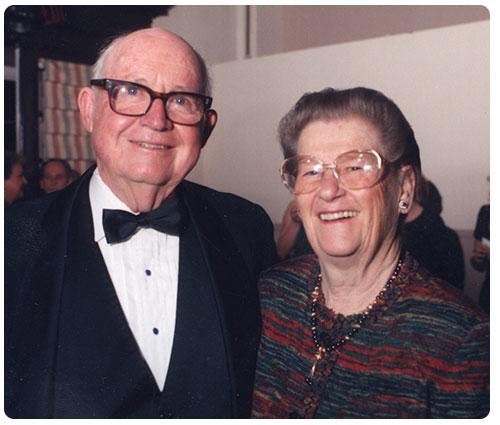
The Campaign for Winthrop - 2003: Winthrop's first capital campaign, "A Lasting Achievement: The Campaign for Winthrop," came to a close with more than $31 million raised.

Student and Professor Working in Lab - 2005: Winthrop garnered a $3.8 million grant from the IDeA Networks of Biomedical Research Excellence program to pursue molecular biomedical research. An anonymous $1.5 million gift was donated to enhance the Winthrop Ballpark.
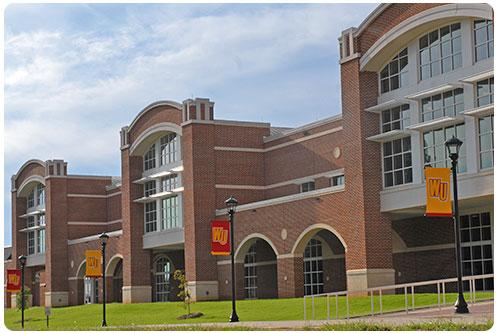
Lois Rhame West Center - 2007: Construction was completed on Winthrop’s first certified “green” building, the Lois Rhame West Health, Physical Education and Wellness Center, as well as on the Glenda Pittman and Charles Jerry Owens Hall.
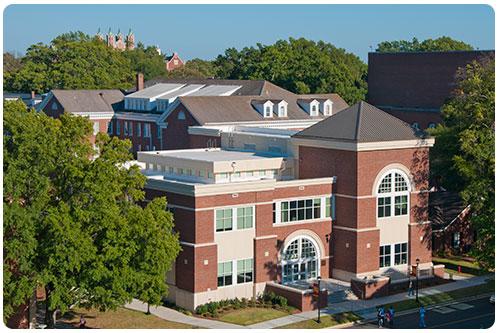
Carroll Hall - 2009: Millions of dollars in federal funds were awarded to Winthrop for such projects as the Richard W. Riley College of Education’s NetSCOPE initiative, the McNair Scholars program, and even a steam line for the campus. Carroll Hall opened with the state-of-the-art Carroll Capital Markets Training and Trading Center as the building’s centerpiece. Homecoming moved to the fall.

DiGiorgio Campus Center lit up at dusk - 2010: The university embarked on its 125th academic year. The DiGiorgio Campus Center was completed in the heart of campus along Scholars Walk. Fire destroyed Owens Hall.

Campaign for Winthrop Logo - 2011: The university launched the public phase of its second capital campaign, “Distinction: The Campaign for Winthrop.” Hardin Family Garden opened at the south end of Scholars Walk.

Daniel F. Mahony - 2015: Winthrop's 11th president, Daniel F. Mahony, was named on July 1, the Distinction campaign reached a successful conclusion that fall, and a strategic planning process began that yielded the Winthrop Plan, the university's blueprint for progress through 2025.

Elizabeth Hope Reed - 2017: Winthrop received the largest estate gift in the university's history— $3 million—to establish a service-focused student scholarship program, thanks to the late Elizabeth Hope Reed '41, '51.
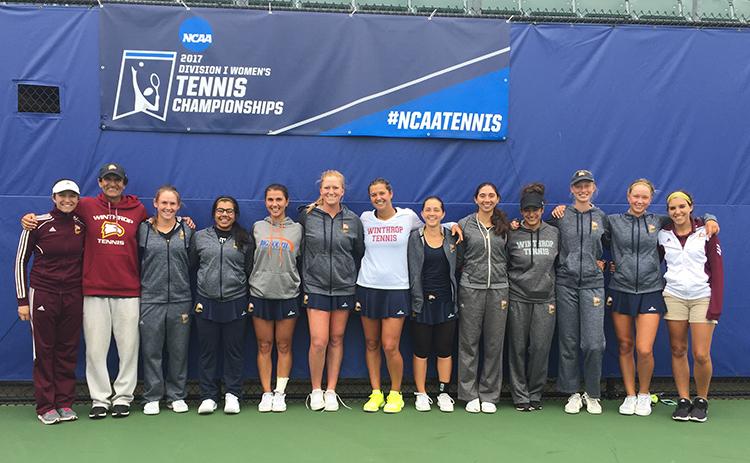
Women's Tennis Team - 2017: The women's tennis team advanced to the second round of the NCAA tournament for the first time

Little Chapel Historical Photo - Founded in 1886 Superintendent of Columbia, S.C., schools David Bancroft Johnson received a $1,500 appropriation from the Peabody Education Board headed by Robert Charles Winthrop to open a school to train young women to teach in the public schools. Classes were first offered at Winthrop Training School in Columbia. Twenty-one students met for classes in the one-room Little Chapel, a carriage house built by Robert Mills, South Carolina architect and designer of the Washington Monument.
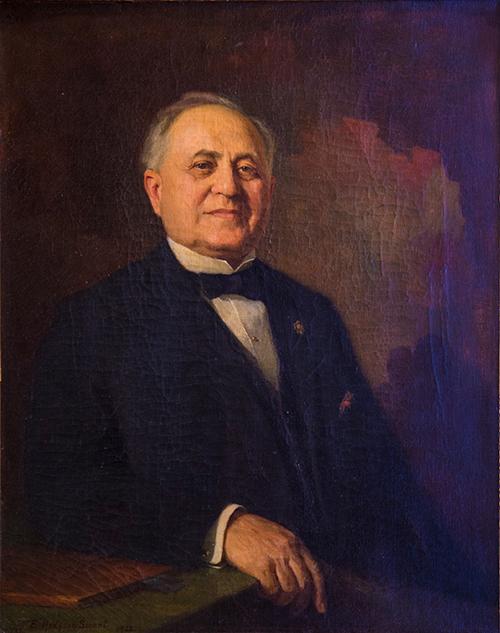
David Bancroft Johnson - 1886: Winthrop grew out of the vision of its founder, David Bancroft Johnson. As superintendent of schools in Columbia, S.C., Johnson was keenly aware of the lack of professionally trained school teachers in the state and felt strongly that a teacher training school was the answer. Johnson served the institution until he died in 1928. His tenure was the longest of any Winthrop president.
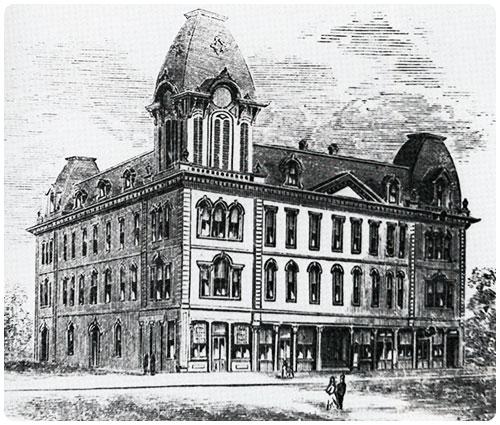
Marion Street House - 1887: Fourteen students graduated at Winthrop’s first commencement at the Columbia City Opera House. South Carolina granted Winthrop a charter and provided $150 per month scholarship to one student from each county in the state; Winthrop relocated to a house on Marion Street where it remained until its move to Rock Hill in 1895.

Historical Photo of a Group of Alumni - 1889: The Winthrop Alumni Association was established.
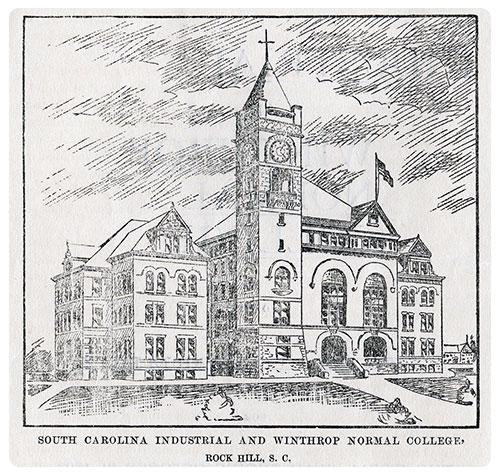
Historical Drawing of Tillman Hall - 1891: The S.C. General Assembly established the South Carolina Industrial and Winthrop Normal College and considered offers from towns competing to be the college’s permanent site. Winthrop started a two-year curriculum.

Winthrop Normal and Industrial College - 1893: The institution's name was changed to the Winthrop Normal and Industrial College of South Carolina.
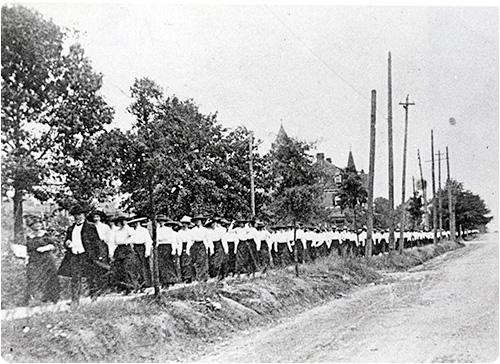
The Blue Line Tradition - 1895: Winthrop began classes in Rock Hill, S.C. A uniform dress code went into effect. A four-year curriculum was instituted. The Blue Line tradition began.
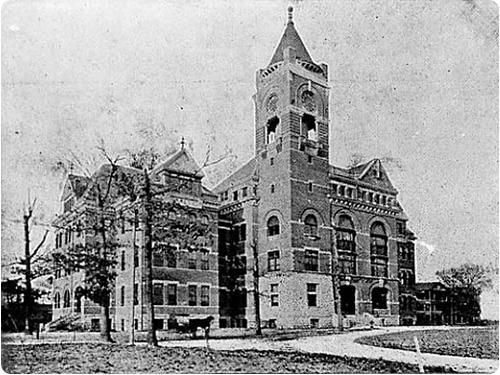
Historical Photo of Tillman Hall - 1898: Tillman / Main Building
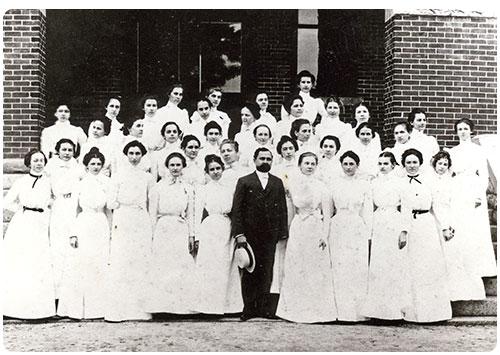
Historical photo of a group of students with D.B. Johnson - 1900: Enrollment topped 500, and Winthrop Kindergarten (now Macfeat Early Childhood Laboratory School) opened.

Historical Photo of Winthrop Training School Building - 1912: The first B.S. and M.A. degrees were conferred, and the Winthrop Training School building (now Withers/W.T.S. Building) was constructed.

Winthrop College Sign - 1920: The institution became Winthrop College, the South Carolina College for Women.
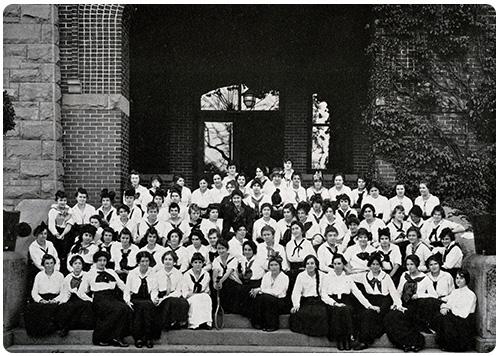
Historical Photo of a Group of Students - 1925: Winthrop became the second largest women's college in the United States.

Newspaper clipping of D.B. Johnson's death - 1928: David Bancroft Johnson died after 42 years of leadership to Winthrop.

James P. Kinard - 1929: James P. Kinard was named second president. He later guided Winthrop through the Depression, and despite the economic crisis, saw to the expansion of Carnegie Library (now Rutledge Building), planning for the amphitheater, and completion of Kinard Building, the main academic facility on campus.

Shelton Phelps - 1934: Shelton Phelps was named third president. He worked to strengthen Winthrop's curriculum and faculty, as well as take advantage of Works Project Administration funds.
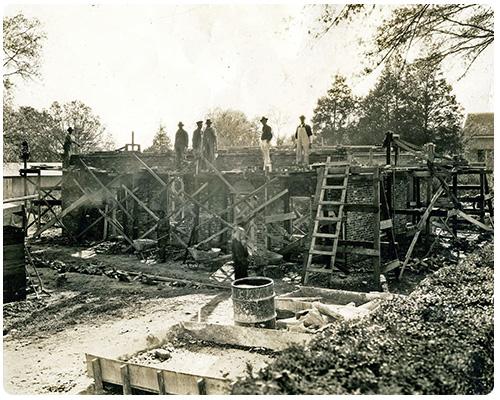
Little Chapel being reconstructed - 1936: The Little Chapel was moved from Columbia to Rock Hill and reconstructed at its present site.

Historical photo of a music professor teaching a class - 1940: The School of Music’s accreditation was Winthrop’s first professional accreditation.
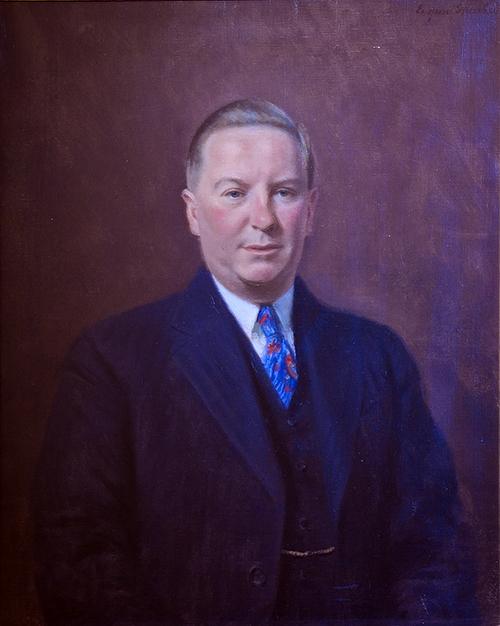
Henry R. Sims - 1944: Henry R. Sims was named fourth president.The noted South Carolina legislator later garnered a near 10-fold increase in the school’s financial base.
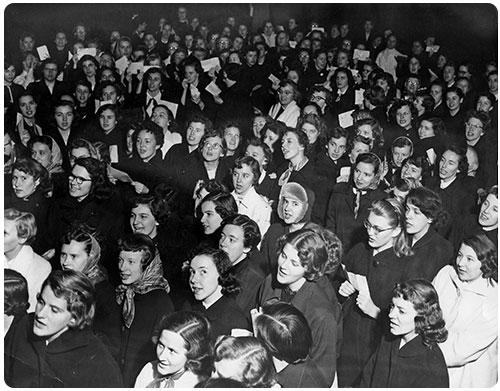
Historical Photo of Student Group - 1953: Enrollment topped 2,000.

Historical Photo of Winthrop Trustees - 1954: Winthrop trustees went on record favoring coeducation.
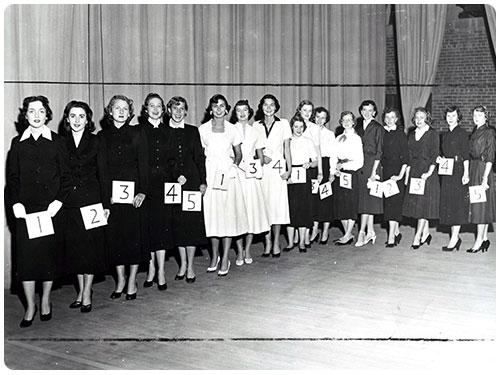
Historical photo of students lined up in different uniforms - 1955: Uniforms were discontinued. D. B. Johnson Memorial Organ was dedicated in Byrnes Auditorium.
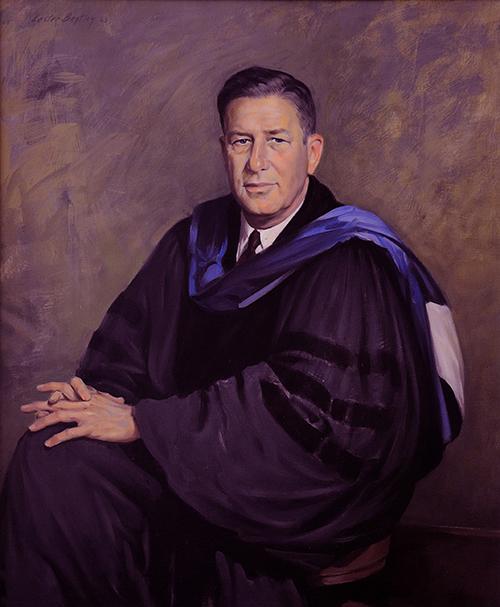
Charles S. Davis - 1959: Charles S. Davis was named fifth president. He later oversaw the gradual closing of Winthrop Training School and made strides in paving the way for integration and coeducation.
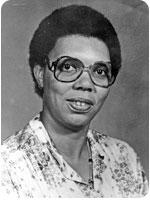
Cynthia Plair Roddey - 1964: Cynthia Plair Roddey, Winthrop's first African-American student, enrolled as a graduate student, and the first Master of Science degree was conferred.

Historical photo of a group of students outside - 1965: Enrollment topped 3,000.
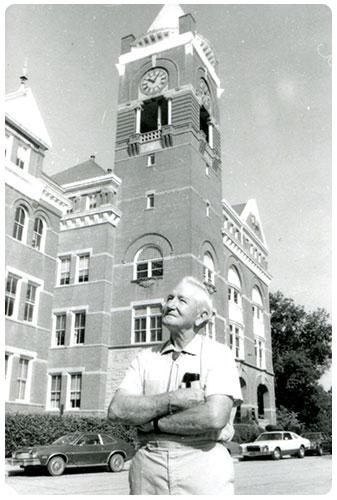
Walter Schrader in front of Tillman Hall - 1969: Graduate student Walter Schrader became the first male to receive a Winthrop degree.
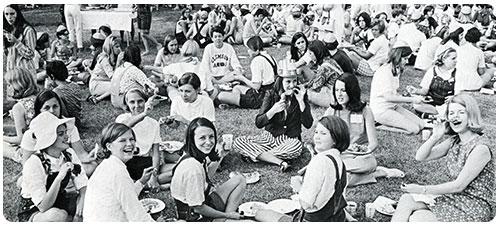
Historical photo of a group of students outside - 1970: Enrollment topped 4,000.
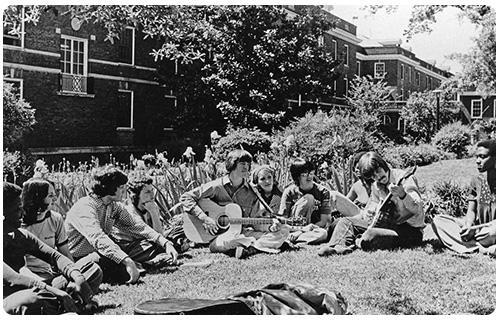
Historical photo of a group of male and female students outside - 1972: The S.C. General Assembly passed limited admission of males.

Charles B. Vail - 1973: Charles B. Vail was named sixth president, coeducation was soon to be fully realized, and the Winthrop Foundation was established.
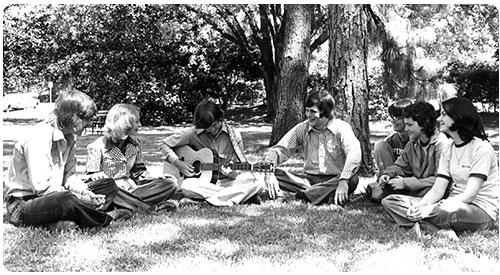
Historical photo of a group of male and female students outside - 1974: Winthrop became fully coeducational.

Phillip Lader - 1983: Phillip Lader was named seventh president. The Blue Line tradition and Convocation were reinstituted. Cultural events were reinstated as a requirement to graduate.
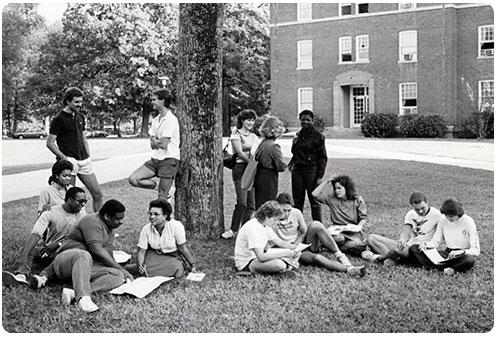
Historical photo of a group of students outside - 1984: Enrollment topped 5,000. Winthrop was admitted to the NCAA. Roger Baumgarte received the first James P. Kinard Award for Excellence in Teaching.
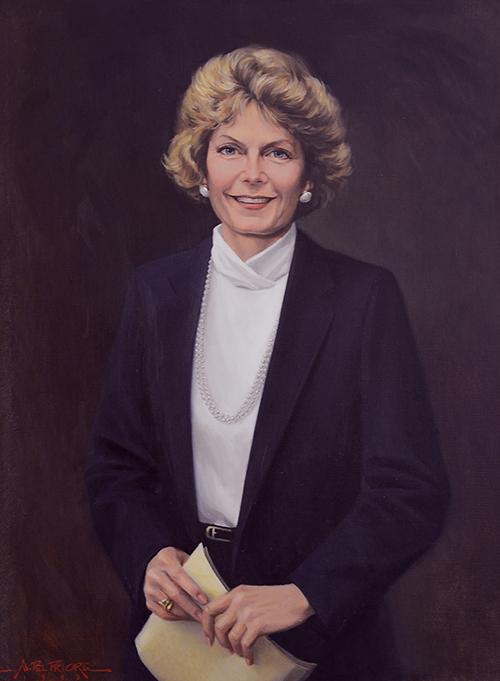
Martha Kime Piper - 1986: Martha Kime Piper became Winthrop’s eighth president. Winthrop celebrated its centennial.

Anthony DiGiorgio - 1989: Anthony DiGiorgio became Winthrop’s ninth president, establishing core institutional values of service, excellence, diversity, community, and leadership. Hurricane Hugo hit the campus.

U.S. News & World Report Logo - 1991: U.S.News & World Report magazine ranked Winthrop among the South’s top universities in its 1992 America’s Best Colleges edition, beginning a tradition of recognition by the magazine that continues today.
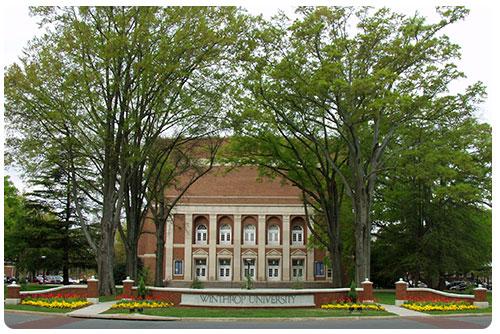
Winthrop University sign in front of Byrnes Auditorium - 1992: Winthrop attained university status.
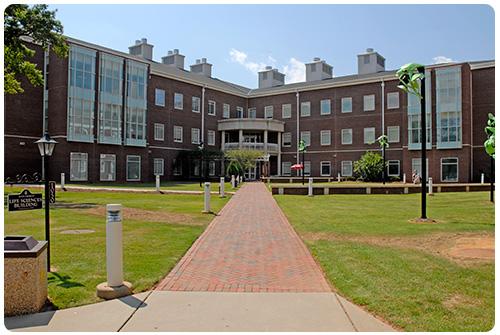
Dalton Hall - 1999: The Winthrop Eagles made the NCAA Division I basketball tournament for the first time in the program's history. The Life Sciences Building (now Dalton Hall) was completed, the first new academic building in more than 30 years.

Group of Students Outside in Blue Line Shirts - 2000: Enrollment topped 6,000. The College of Education was renamed the Richard W. Riley College of Education for the former Secretary of Education under President Bill Clinton.

The Campaign for Winthrop - 2003: Winthrop's first capital campaign, "A Lasting Achievement: The Campaign for Winthrop," came to a close with more than $31 million raised.

Student and Professor Working in Lab - 2005: Winthrop garnered a $3.8 million grant from the IDeA Networks of Biomedical Research Excellence program to pursue molecular biomedical research. An anonymous $1.5 million gift was donated to enhance the Winthrop Ballpark.

Lois Rhame West Center - 2007: Construction was completed on Winthrop’s first certified “green” building, the Lois Rhame West Health, Physical Education and Wellness Center, as well as on the Glenda Pittman and Charles Jerry Owens Hall.

Carroll Hall - 2009: Millions of dollars in federal funds were awarded to Winthrop for such projects as the Richard W. Riley College of Education’s NetSCOPE initiative, the McNair Scholars program, and even a steam line for the campus. Carroll Hall opened with the state-of-the-art Carroll Capital Markets Training and Trading Center as the building’s centerpiece. Homecoming moved to the fall.

DiGiorgio Campus Center lit up at dusk - 2010: The university embarked on its 125th academic year. The DiGiorgio Campus Center was completed in the heart of campus along Scholars Walk. Fire destroyed Owens Hall.

Campaign for Winthrop Logo - 2011: The university launched the public phase of its second capital campaign, “Distinction: The Campaign for Winthrop.” Hardin Family Garden opened at the south end of Scholars Walk.

Daniel F. Mahony - 2015: Winthrop's 11th president, Daniel F. Mahony, was named on July 1, the Distinction campaign reached a successful conclusion that fall, and a strategic planning process began that yielded the Winthrop Plan, the university's blueprint for progress through 2025.

Elizabeth Hope Reed - 2017: Winthrop received the largest estate gift in the university's history— $3 million—to establish a service-focused student scholarship program, thanks to the late Elizabeth Hope Reed '41, '51.

Women's Tennis Team - 2017: The women's tennis team advanced to the second round of the NCAA tournament for the first time

Little Chapel Historical Photo - Founded in 1886 Superintendent of Columbia, S.C., schools David Bancroft Johnson received a $1,500 appropriation from the Peabody Education Board headed by Robert Charles Winthrop to open a school to train young women to teach in the public schools. Classes were first offered at Winthrop Training School in Columbia. Twenty-one students met for classes in the one-room Little Chapel, a carriage house built by Robert Mills, South Carolina architect and designer of the Washington Monument.

David Bancroft Johnson - 1886: Winthrop grew out of the vision of its founder, David Bancroft Johnson. As superintendent of schools in Columbia, S.C., Johnson was keenly aware of the lack of professionally trained school teachers in the state and felt strongly that a teacher training school was the answer. Johnson served the institution until he died in 1928. His tenure was the longest of any Winthrop president.

Marion Street House - 1887: Fourteen students graduated at Winthrop’s first commencement at the Columbia City Opera House. South Carolina granted Winthrop a charter and provided $150 per month scholarship to one student from each county in the state; Winthrop relocated to a house on Marion Street where it remained until its move to Rock Hill in 1895.

Historical Photo of a Group of Alumni - 1889: The Winthrop Alumni Association was established.

Historical Drawing of Tillman Hall - 1891: The S.C. General Assembly established the South Carolina Industrial and Winthrop Normal College and considered offers from towns competing to be the college’s permanent site. Winthrop started a two-year curriculum.

Winthrop Normal and Industrial College - 1893: The institution's name was changed to the Winthrop Normal and Industrial College of South Carolina.

The Blue Line Tradition - 1895: Winthrop began classes in Rock Hill, S.C. A uniform dress code went into effect. A four-year curriculum was instituted. The Blue Line tradition began.

Historical Photo of Tillman Hall - 1898: Tillman / Main Building

Historical photo of a group of students with D.B. Johnson - 1900: Enrollment topped 500, and Winthrop Kindergarten (now Macfeat Early Childhood Laboratory School) opened.

Historical Photo of Winthrop Training School Building - 1912: The first B.S. and M.A. degrees were conferred, and the Winthrop Training School building (now Withers/W.T.S. Building) was constructed.

Winthrop College Sign - 1920: The institution became Winthrop College, the South Carolina College for Women.

Historical Photo of a Group of Students - 1925: Winthrop became the second largest women's college in the United States.

Newspaper clipping of D.B. Johnson's death - 1928: David Bancroft Johnson died after 42 years of leadership to Winthrop.

James P. Kinard - 1929: James P. Kinard was named second president. He later guided Winthrop through the Depression, and despite the economic crisis, saw to the expansion of Carnegie Library (now Rutledge Building), planning for the amphitheater, and completion of Kinard Building, the main academic facility on campus.

Shelton Phelps - 1934: Shelton Phelps was named third president. He worked to strengthen Winthrop's curriculum and faculty, as well as take advantage of Works Project Administration funds.

Little Chapel being reconstructed - 1936: The Little Chapel was moved from Columbia to Rock Hill and reconstructed at its present site.

Historical photo of a music professor teaching a class - 1940: The School of Music’s accreditation was Winthrop’s first professional accreditation.

Henry R. Sims - 1944: Henry R. Sims was named fourth president.The noted South Carolina legislator later garnered a near 10-fold increase in the school’s financial base.

Historical Photo of Student Group - 1953: Enrollment topped 2,000.

Historical Photo of Winthrop Trustees - 1954: Winthrop trustees went on record favoring coeducation.

Historical photo of students lined up in different uniforms - 1955: Uniforms were discontinued. D. B. Johnson Memorial Organ was dedicated in Byrnes Auditorium.

Charles S. Davis - 1959: Charles S. Davis was named fifth president. He later oversaw the gradual closing of Winthrop Training School and made strides in paving the way for integration and coeducation.

Cynthia Plair Roddey - 1964: Cynthia Plair Roddey, Winthrop's first African-American student, enrolled as a graduate student, and the first Master of Science degree was conferred.

Historical photo of a group of students outside - 1965: Enrollment topped 3,000.

Walter Schrader in front of Tillman Hall - 1969: Graduate student Walter Schrader became the first male to receive a Winthrop degree.

Historical photo of a group of students outside - 1970: Enrollment topped 4,000.

Historical photo of a group of male and female students outside - 1972: The S.C. General Assembly passed limited admission of males.

Charles B. Vail - 1973: Charles B. Vail was named sixth president, coeducation was soon to be fully realized, and the Winthrop Foundation was established.

Historical photo of a group of male and female students outside - 1974: Winthrop became fully coeducational.

Phillip Lader - 1983: Phillip Lader was named seventh president. The Blue Line tradition and Convocation were reinstituted. Cultural events were reinstated as a requirement to graduate.

Historical photo of a group of students outside - 1984: Enrollment topped 5,000. Winthrop was admitted to the NCAA. Roger Baumgarte received the first James P. Kinard Award for Excellence in Teaching.

Martha Kime Piper - 1986: Martha Kime Piper became Winthrop’s eighth president. Winthrop celebrated its centennial.

Anthony DiGiorgio - 1989: Anthony DiGiorgio became Winthrop’s ninth president, establishing core institutional values of service, excellence, diversity, community, and leadership. Hurricane Hugo hit the campus.

U.S. News & World Report Logo - 1991: U.S.News & World Report magazine ranked Winthrop among the South’s top universities in its 1992 America’s Best Colleges edition, beginning a tradition of recognition by the magazine that continues today.

Winthrop University sign in front of Byrnes Auditorium - 1992: Winthrop attained university status.

Dalton Hall - 1999: The Winthrop Eagles made the NCAA Division I basketball tournament for the first time in the program's history. The Life Sciences Building (now Dalton Hall) was completed, the first new academic building in more than 30 years.

Group of Students Outside in Blue Line Shirts - 2000: Enrollment topped 6,000. The College of Education was renamed the Richard W. Riley College of Education for the former Secretary of Education under President Bill Clinton.

The Campaign for Winthrop - 2003: Winthrop's first capital campaign, "A Lasting Achievement: The Campaign for Winthrop," came to a close with more than $31 million raised.

Student and Professor Working in Lab - 2005: Winthrop garnered a $3.8 million grant from the IDeA Networks of Biomedical Research Excellence program to pursue molecular biomedical research. An anonymous $1.5 million gift was donated to enhance the Winthrop Ballpark.

Lois Rhame West Center - 2007: Construction was completed on Winthrop’s first certified “green” building, the Lois Rhame West Health, Physical Education and Wellness Center, as well as on the Glenda Pittman and Charles Jerry Owens Hall.

Carroll Hall - 2009: Millions of dollars in federal funds were awarded to Winthrop for such projects as the Richard W. Riley College of Education’s NetSCOPE initiative, the McNair Scholars program, and even a steam line for the campus. Carroll Hall opened with the state-of-the-art Carroll Capital Markets Training and Trading Center as the building’s centerpiece. Homecoming moved to the fall.

DiGiorgio Campus Center lit up at dusk - 2010: The university embarked on its 125th academic year. The DiGiorgio Campus Center was completed in the heart of campus along Scholars Walk. Fire destroyed Owens Hall.

Campaign for Winthrop Logo - 2011: The university launched the public phase of its second capital campaign, “Distinction: The Campaign for Winthrop.” Hardin Family Garden opened at the south end of Scholars Walk.

Daniel F. Mahony - 2015: Winthrop's 11th president, Daniel F. Mahony, was named on July 1, the Distinction campaign reached a successful conclusion that fall, and a strategic planning process began that yielded the Winthrop Plan, the university's blueprint for progress through 2025.

Elizabeth Hope Reed - 2017: Winthrop received the largest estate gift in the university's history— $3 million—to establish a service-focused student scholarship program, thanks to the late Elizabeth Hope Reed '41, '51.

Women's Tennis Team - 2017: The women's tennis team advanced to the second round of the NCAA tournament for the first time

Little Chapel Historical Photo - Founded in 1886 Superintendent of Columbia, S.C., schools David Bancroft Johnson received a $1,500 appropriation from the Peabody Education Board headed by Robert Charles Winthrop to open a school to train young women to teach in the public schools. Classes were first offered at Winthrop Training School in Columbia. Twenty-one students met for classes in the one-room Little Chapel, a carriage house built by Robert Mills, South Carolina architect and designer of the Washington Monument.

David Bancroft Johnson - 1886: Winthrop grew out of the vision of its founder, David Bancroft Johnson. As superintendent of schools in Columbia, S.C., Johnson was keenly aware of the lack of professionally trained school teachers in the state and felt strongly that a teacher training school was the answer. Johnson served the institution until he died in 1928. His tenure was the longest of any Winthrop president.

Marion Street House - 1887: Fourteen students graduated at Winthrop’s first commencement at the Columbia City Opera House. South Carolina granted Winthrop a charter and provided $150 per month scholarship to one student from each county in the state; Winthrop relocated to a house on Marion Street where it remained until its move to Rock Hill in 1895.

Historical Photo of a Group of Alumni - 1889: The Winthrop Alumni Association was established.

Historical Drawing of Tillman Hall - 1891: The S.C. General Assembly established the South Carolina Industrial and Winthrop Normal College and considered offers from towns competing to be the college’s permanent site. Winthrop started a two-year curriculum.

Winthrop Normal and Industrial College - 1893: The institution's name was changed to the Winthrop Normal and Industrial College of South Carolina.

The Blue Line Tradition - 1895: Winthrop began classes in Rock Hill, S.C. A uniform dress code went into effect. A four-year curriculum was instituted. The Blue Line tradition began.

Historical Photo of Tillman Hall - 1898: Tillman / Main Building

Historical photo of a group of students with D.B. Johnson - 1900: Enrollment topped 500, and Winthrop Kindergarten (now Macfeat Early Childhood Laboratory School) opened.

Historical Photo of Winthrop Training School Building - 1912: The first B.S. and M.A. degrees were conferred, and the Winthrop Training School building (now Withers/W.T.S. Building) was constructed.

Winthrop College Sign - 1920: The institution became Winthrop College, the South Carolina College for Women.

Historical Photo of a Group of Students - 1925: Winthrop became the second largest women's college in the United States.

Newspaper clipping of D.B. Johnson's death - 1928: David Bancroft Johnson died after 42 years of leadership to Winthrop.

James P. Kinard - 1929: James P. Kinard was named second president. He later guided Winthrop through the Depression, and despite the economic crisis, saw to the expansion of Carnegie Library (now Rutledge Building), planning for the amphitheater, and completion of Kinard Building, the main academic facility on campus.

Shelton Phelps - 1934: Shelton Phelps was named third president. He worked to strengthen Winthrop's curriculum and faculty, as well as take advantage of Works Project Administration funds.

Little Chapel being reconstructed - 1936: The Little Chapel was moved from Columbia to Rock Hill and reconstructed at its present site.

Historical photo of a music professor teaching a class - 1940: The School of Music’s accreditation was Winthrop’s first professional accreditation.

Henry R. Sims - 1944: Henry R. Sims was named fourth president.The noted South Carolina legislator later garnered a near 10-fold increase in the school’s financial base.

Historical Photo of Student Group - 1953: Enrollment topped 2,000.

Historical Photo of Winthrop Trustees - 1954: Winthrop trustees went on record favoring coeducation.

Historical photo of students lined up in different uniforms - 1955: Uniforms were discontinued. D. B. Johnson Memorial Organ was dedicated in Byrnes Auditorium.

Charles S. Davis - 1959: Charles S. Davis was named fifth president. He later oversaw the gradual closing of Winthrop Training School and made strides in paving the way for integration and coeducation.

Cynthia Plair Roddey - 1964: Cynthia Plair Roddey, Winthrop's first African-American student, enrolled as a graduate student, and the first Master of Science degree was conferred.

Historical photo of a group of students outside - 1965: Enrollment topped 3,000.

Walter Schrader in front of Tillman Hall - 1969: Graduate student Walter Schrader became the first male to receive a Winthrop degree.

Historical photo of a group of students outside - 1970: Enrollment topped 4,000.

Historical photo of a group of male and female students outside - 1972: The S.C. General Assembly passed limited admission of males.

Charles B. Vail - 1973: Charles B. Vail was named sixth president, coeducation was soon to be fully realized, and the Winthrop Foundation was established.

Historical photo of a group of male and female students outside - 1974: Winthrop became fully coeducational.

Phillip Lader - 1983: Phillip Lader was named seventh president. The Blue Line tradition and Convocation were reinstituted. Cultural events were reinstated as a requirement to graduate.

Historical photo of a group of students outside - 1984: Enrollment topped 5,000. Winthrop was admitted to the NCAA. Roger Baumgarte received the first James P. Kinard Award for Excellence in Teaching.

Martha Kime Piper - 1986: Martha Kime Piper became Winthrop’s eighth president. Winthrop celebrated its centennial.

Anthony DiGiorgio - 1989: Anthony DiGiorgio became Winthrop’s ninth president, establishing core institutional values of service, excellence, diversity, community, and leadership. Hurricane Hugo hit the campus.

U.S. News & World Report Logo - 1991: U.S.News & World Report magazine ranked Winthrop among the South’s top universities in its 1992 America’s Best Colleges edition, beginning a tradition of recognition by the magazine that continues today.

Winthrop University sign in front of Byrnes Auditorium - 1992: Winthrop attained university status.

Dalton Hall - 1999: The Winthrop Eagles made the NCAA Division I basketball tournament for the first time in the program's history. The Life Sciences Building (now Dalton Hall) was completed, the first new academic building in more than 30 years.

Group of Students Outside in Blue Line Shirts - 2000: Enrollment topped 6,000. The College of Education was renamed the Richard W. Riley College of Education for the former Secretary of Education under President Bill Clinton.

The Campaign for Winthrop - 2003: Winthrop's first capital campaign, "A Lasting Achievement: The Campaign for Winthrop," came to a close with more than $31 million raised.

Student and Professor Working in Lab - 2005: Winthrop garnered a $3.8 million grant from the IDeA Networks of Biomedical Research Excellence program to pursue molecular biomedical research. An anonymous $1.5 million gift was donated to enhance the Winthrop Ballpark.

Lois Rhame West Center - 2007: Construction was completed on Winthrop’s first certified “green” building, the Lois Rhame West Health, Physical Education and Wellness Center, as well as on the Glenda Pittman and Charles Jerry Owens Hall.

Carroll Hall - 2009: Millions of dollars in federal funds were awarded to Winthrop for such projects as the Richard W. Riley College of Education’s NetSCOPE initiative, the McNair Scholars program, and even a steam line for the campus. Carroll Hall opened with the state-of-the-art Carroll Capital Markets Training and Trading Center as the building’s centerpiece. Homecoming moved to the fall.

DiGiorgio Campus Center lit up at dusk - 2010: The university embarked on its 125th academic year. The DiGiorgio Campus Center was completed in the heart of campus along Scholars Walk. Fire destroyed Owens Hall.

Campaign for Winthrop Logo - 2011: The university launched the public phase of its second capital campaign, “Distinction: The Campaign for Winthrop.” Hardin Family Garden opened at the south end of Scholars Walk.

Daniel F. Mahony - 2015: Winthrop's 11th president, Daniel F. Mahony, was named on July 1, the Distinction campaign reached a successful conclusion that fall, and a strategic planning process began that yielded the Winthrop Plan, the university's blueprint for progress through 2025.

Elizabeth Hope Reed - 2017: Winthrop received the largest estate gift in the university's history— $3 million—to establish a service-focused student scholarship program, thanks to the late Elizabeth Hope Reed '41, '51.

Women's Tennis Team - 2017: The women's tennis team advanced to the second round of the NCAA tournament for the first time